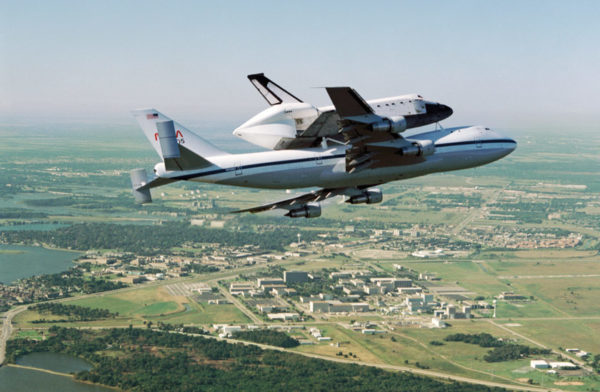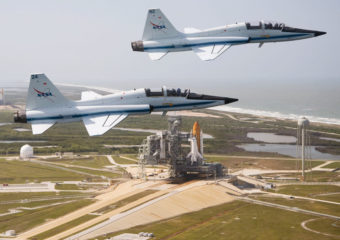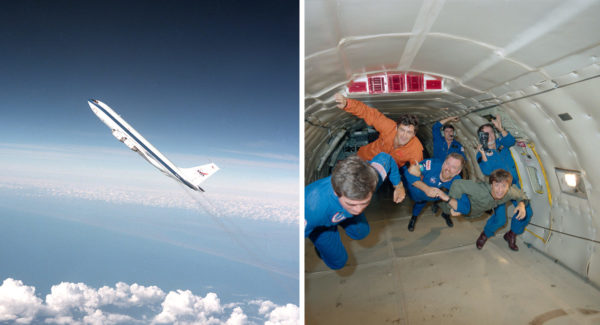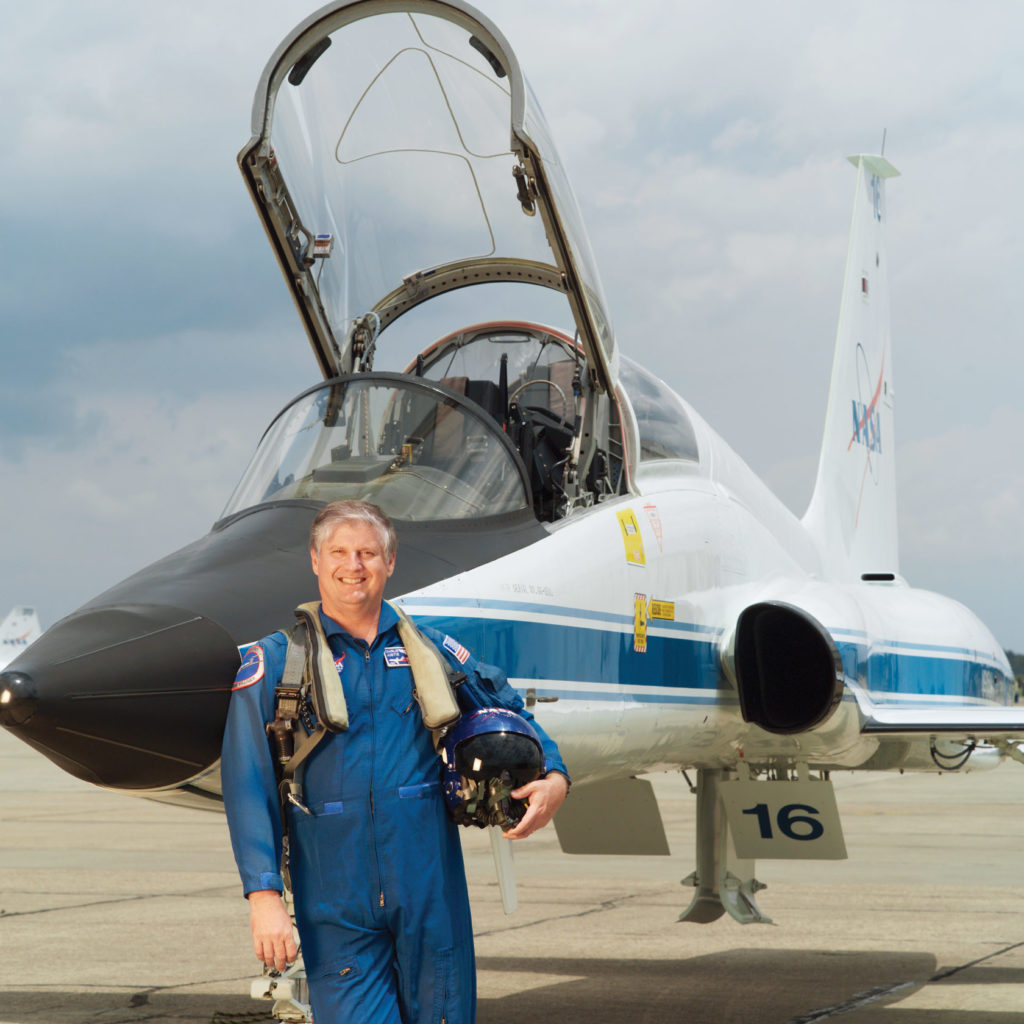Whether flying a sleek T-38 (above) or a 747 with an orbiter piggyback (see below), Charlie says, “You’re getting bombarded by radiation up there — and we knew it. We were well aware that this exposure has a cumulative effect, and we could be paying for it later.” Credit: Dayne Steele
Did you know that as your altitude increases, so does your risk for skin cancer? More radiation reaches you up there. Skiers (who go high), pilots (higher) and astronauts (highest) have all experienced the consequences. We talked with extraordinary achievers who have learned to protect themselves — and who explain why they chose to enter a field with so many dangers. In part 1, we start with ski racer champion Erik Schlopy in Park City, Utah. In Part 2 (HIGHER), we feature NASA pilot Charles R. Justiz, PhD. And in part 3, we hear from astronaut Scott Kelly, who spent a year on the space station.
Who:
Pilot Charles R. Justiz, PhD
Activity:
22,000 flight hours in more than 100 different types of aircraft
Notable achievement:
Trained every NASA space shuttle astronaut how to land the orbiter
Adorable fact:
Flew the “Vomit Comet” plane with cast and crew of the film Apollo 13 to film scenes simulating zero-G
Type of altitude:
Atmospheric
Place:
Houston, when not traveling
Level of altitude:
Up to 70,000 feet
Charlie Justiz spent 40 years in a cockpit for the U.S. Air Force and at NASA, piloting almost every kind of flying machine you can imagine, and at least a couple that you probably can’t. He flew fast (more than Mach 2, or 1,400 miles per hour!) in the F-4 and the F-111 and high (nearly 70,000 feet) in NASA’s special B-57 aircraft, as well as up and down in NASA’s reduced-gravity airplane, affectionately known as the “Vomit Comet.” His experience, deep knowledge of how aviation works (with a PhD in mechanical engineering) and creative streak (he writes science fiction), make for fascinating conversation:
Julie Bain: Why did you choose a life of flying, and what do you love most about being up there?
Charlie Justiz: Flying takes a certain kind of mindset. I started as a kid in Miami. My dad began taking flying lessons to help him get over his fear of heights, and he offered to split a lesson with me. I never understood his fear of heights; I was not wired that way. As I got off the ground that first time, I said, “Oh, this is so much fun!” I was fascinated by the challenge of controlling the plane and making it do exactly what I wanted it to, and the sense of freedom was intoxicating! I loved it, and that thrill of flying has never gone away.
JB: To transport the space shuttle, you flew the orbiter on the back of a big old 747. Who on Earth thought of that, and how’d you learn to do it?
CJ: Yes, I was an instructor-captain of the 747 with the space shuttle on the back, and it was probably the goofiest thing I’ve ever flown in my life. The idea was brilliantly, remarkably stupid-clever. It was the brainchild of an engineer, John Kiker, who knew how the thinking and culture of NASA worked. The orbiter couldn’t be moved by rails or trucks because the wings couldn’t be removed, and it wouldn’t fit through tunnels. You couldn’t put it on a barge and take it through the Panama Canal because of corrosion. His idea really was the only way we could move it, but flying it was another story.

Imagine flying a million-pound 747 with a space shuttle piggyback! Credit: NASA/Robert Markowitz
Usually, the 747 was the sweetest, easiest airplane in the universe to fly. You have a million pounds worth of airplane, and it handles like a puppy dog. But once you put the orbiter on its back, it changed its attitude, and it flew completely differently. For one thing, you use up every inch of runway. You have to build up so much speed to get off the ground that when you take off, and you bring the hot tires into the wheel wells, it smells like burning rubber.
JB: Is it the weight, the aerodynamics?
CJ: The aerodynamics are the main problem. When the orbiter is on the 747, the orbiter lifts its own weight at cruise speeds. What it does not do is compensate for the drag, because it can’t, and you still have to get to cruise speed. I did a lot of intensive training for that, including a simulator that simulated having the orbiter on the back. What the simulator did not prepare you for was the steady vibrations that were constantly pulsing the yoke as you fly, or the unexpected responses to wind gusts. You simulate all of the emergencies and what you would need to do, and eventually it becomes second nature. That’s the exciting part for a pilot. I want to know every rivet of the vehicle, so I was happy to absorb that kind of knowledge and let the vehicle talk to me.

Charlie flying a T-38 over NASA’s Kennedy Space Center launch pads in 2009 with his friend Jack (“Triple”) Nickel in the T-38 above him. Credit: NASA/Robert Markowitz
JB: On the opposite side of the aviation spectrum, the classic, sleek, fast T-38 is a pilot favorite. Can you describe why?
CJ: The thing about the T-38 is that you wear it more than actually fly it. You’re on the end of a stick, and the visibility is wonderful. It’s you and the universe. You have to constantly monitor it and stay in control. But there is a wonderful sense of communion when you’re flying that plane.”
JB: You also flew the KC-135 training aircraft, more commonly known as the “Vomit Comet” for the side effects trainees sometimes experience. How does it simulate weightlessness?
CJ: We say we fly in parabolas (like a sound wave). When I am pulling the nose up, those onboard experience almost 2 Gs and feel pushed down against the floor. At a precise point, I push the nose down and move the floor out from under everyone and they’re free-falling. What’s really happening is the plane’s floor is moving away from them at the same rate they’re falling so it feels like floating. We could only do 40 parabolas before we stopped due to fuel considerations. Each parabola is about 20 seconds of zero-G followed by about 20 seconds of around 2 Gs, one after the other. Yes, some people feel nauseous — and others love it!”

The specially modified turbojet known as the Vomit Comet (flying a parabola) has a large, padded interior cargo bay for training astronauts. Credit: NASA
JB: Why did you fly to such high altitude for NASA, and how dangerous was that?
CJ: We used a WB-57 to take readings and collect air samples of the Earth’s upper atmosphere. It was research to learn more about how the composition of our atmosphere changes over time and to see how much bombardment we’re getting from cosmic rays and other radiation at high altitude or in space and the effects it might have on the human body.
JB: In the cockpit, how were you protecting yourself from that radiation you were studying?
CJ: It’s surprising how protected you are in many of the planes I’ve flown, mainly to protect you from the other risks. For example, in the WB-57, I was covered in a full pressure suit to keep me safe and warm up there. If I was sitting in an ejection seat-equipped aircraft, I was given a flameproof flight suit and gloves, because if there’s a fire, you have to be able to eject yourself. And you have a helmet and boots and a parachute on your back. So, you’re very covered against UV radiation.
Probably the worst threat you had was when you were forced to remove protections to your hands and eyes so you could perform some function. Pilots understand there is strong UV radiation up there, but they will remove protective gloves to adjust equipment that is difficult to adjust with gloves on. Also, pilots will do what they can to improve their ability to see, including taking off sunglasses in certain cases. In the older airplanes, such as the T-38 that was first flown in 1959, the canopy, which is almost constantly facing the sun on most flights, was a quarter of an inch of old-style Plexiglas that let almost every photon through.
JB: So, it sounds like you could get really burned on your face, I imagine?
CJ: And the back of your hands. I was guilty of taking off my gloves to work the cockpit controls and now, because of that, I’ve had to fight some squamous cell carcinomas. I’ve had some Mohs surgery. Skin cancer is definitely one of the risks of high-altitude flights for pilots. As religious as I was about training and safety in my airplanes, now I am just as religious about seeing my doctors about my skin. That is part of the price pilots have to pay for the privilege of flying above our beautiful planet.




